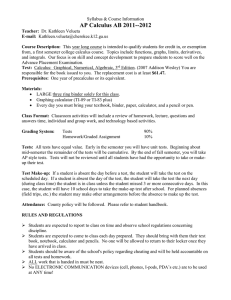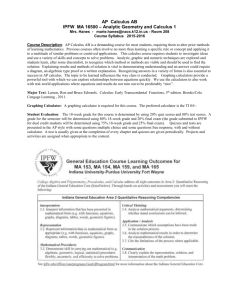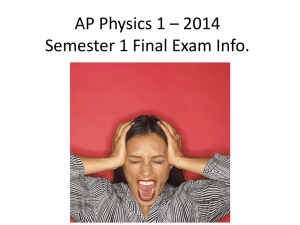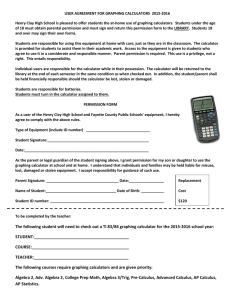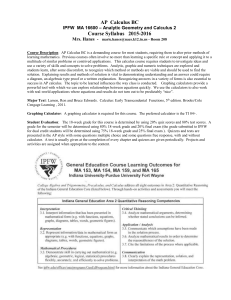AP Calculus AB MATH 1325
advertisement
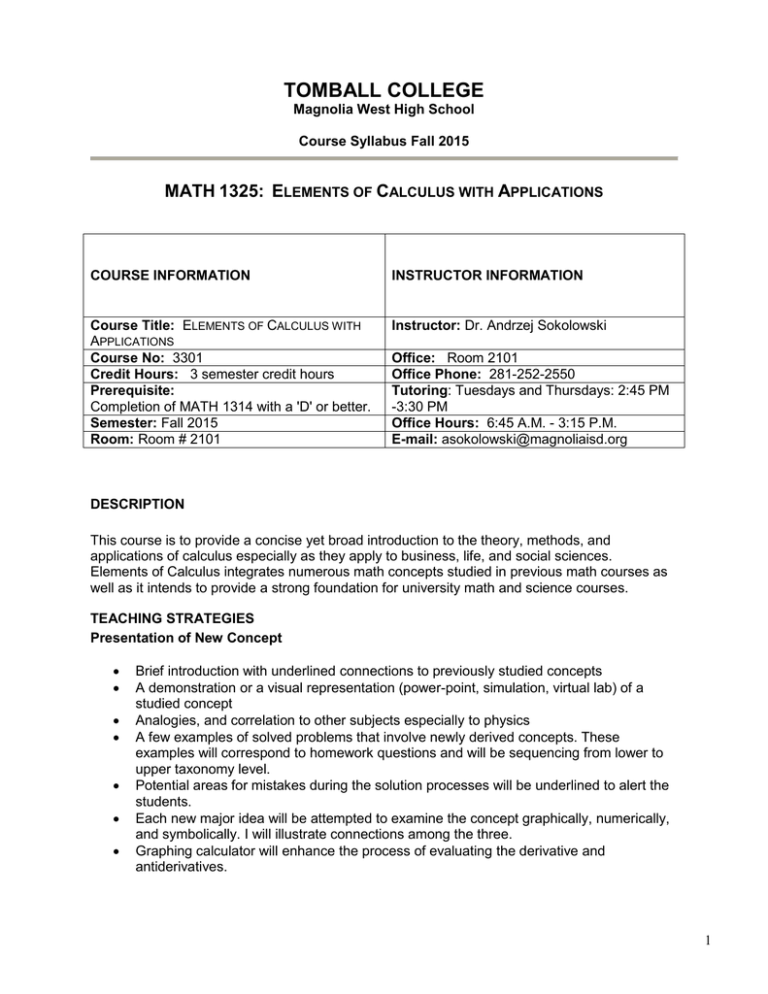
TOMBALL COLLEGE Magnolia West High School Course Syllabus Fall 2015 MATH 1325: ELEMENTS OF CALCULUS WITH APPLICATIONS COURSE INFORMATION INSTRUCTOR INFORMATION Course Title: ELEMENTS OF CALCULUS WITH APPLICATIONS Course No: 3301 Credit Hours: 3 semester credit hours Prerequisite: Completion of MATH 1314 with a 'D' or better. Semester: Fall 2015 Room: Room # 2101 Instructor: Dr. Andrzej Sokolowski Office: Room 2101 Office Phone: 281-252-2550 Tutoring: Tuesdays and Thursdays: 2:45 PM -3:30 PM Office Hours: 6:45 A.M. - 3:15 P.M. E-mail: asokolowski@magnoliaisd.org DESCRIPTION This course is to provide a concise yet broad introduction to the theory, methods, and applications of calculus especially as they apply to business, life, and social sciences. Elements of Calculus integrates numerous math concepts studied in previous math courses as well as it intends to provide a strong foundation for university math and science courses. TEACHING STRATEGIES Presentation of New Concept Brief introduction with underlined connections to previously studied concepts A demonstration or a visual representation (power-point, simulation, virtual lab) of a studied concept Analogies, and correlation to other subjects especially to physics A few examples of solved problems that involve newly derived concepts. These examples will correspond to homework questions and will be sequencing from lower to upper taxonomy level. Potential areas for mistakes during the solution processes will be underlined to alert the students. Each new major idea will be attempted to examine the concept graphically, numerically, and symbolically. I will illustrate connections among the three. Graphing calculator will enhance the process of evaluating the derivative and antiderivatives. 1 Laboratory Activities Laboratory activities are essential not only to science but also to major mathematics courses as they provide opportunity to test the validity of studied laws and encourage communications among students. The labs will focus on the following methodologies: They will lead to discovery of a fundamental quantities; for example the magnitude of earth’s acceleration; formulas for volume or area, rate of change or parametric representations. Students will apply or verify concepts studied in class; Riemann sums; rate of flow; applications of related rates; sinusoidal functions etc. Labs will also enhance the process of utilizing graphing calculator whenever it will be possible. Students will be required to complete a lab in each of the major sections. The focus of labs will be placed on the analysis of the outcomes. I will recommend and encourage the students to have lab analysis adhere to the guidelines of technical paper. All labs will have thought-provoking questions and should provide a transition to text based problems. Assessments Assessment in this class will be composed of variety of elements. One of the elements is to ensure that students are familiar with using graphing calculator to perform the four basic operations; graphing a function in an arbitrary window, finding roots and points of intersection, finding numerical value for derivatives, and evaluating definite integrals. Students will be asked to use the calculator to investigate concepts such as limits by using the trace and table operations to make conjectures about the answers. Quizzes will be assigned frequently to assess students’ understanding of the material. A 10 -15 minute quiz will combine multiple choice and/or free response questions. This type of quizzes needs to be announced. Quiz results will be discussed by the teacher and possible sources of errors (concept not learned, calculation problems, question not clearly stated) will be highlighted. Tests will be usually assigned at the end of a chapter followed by a review. The content of the tests will contain free response and multiple choice questions. Some of the tests will require a graphing calculator; some will be taken without it. Since the tests will reflect an AP level, the instructor might curve them accordingly. The expectations should be gradually increasing and the curve eliminated as the students are gearing toward the end of the course. Requirement Percent of Final grade Letter Grade Percentage Range MAJOR TESTS 54% A 90% -100% HOMEWORK & QUIZZES 14% 9-WEEK EXAM 12% B C D 80% - 89% 70% - 79% 60% - 69% FINAL EXAM 20% F <60% 2 OBJECTIVES In completing this course, students will: Be able to apply functions expressed graphically, numerically, analytically, and verbally to model real life situations. Understand the differences between the process of differentiation and integration as they apply to real life situations. Expand their mathematical knowledge including, theories, techniques, concepts, and generalization. Improve their problem solving ability; ability to ask mathematical questions and to obtain solutions to problems by use of quantitative and qualitative reasoning and experimental investigation. Experience appreciation of mathematical world. Develop curiosity, creativity, and reasoned skepticism. Explore connections of calculus to other disciplines especially to physics. TEXTBOOKS AND MATERIALS Calculus for Business, Economics, Life Sciences and Social Sciences (12th Edition) by Raymond A. Barnett, Michael R. Ziegler and Karl E. Byleen. A graphing calculator or any scientific calculator with trigonometric functions and functions to evaluate derivatives and integrals (TI - 83+, 86 or 89). MAKE – UP TESTS AND LATE WORK Late work evaluation is determined by the school policy Retesting is not allowed in a dual credit class WITHDRAWAL POLICY: I do not “withdraw” students. That would be up to you. However, if you are considering withdrawing from this course – I encourage that you see me first! Let’s talk about it. Perhaps we can find a way to help you be successful! Withdrawal from the course after the official day of record (see current catalog) will result in a final grade of “W” on the student transcript and no credit will be awarded. It is the student’s responsibility to initiate and complete a request for withdrawal from any course. Withdrawals are processed only if the student completes and submits for signature(s) the required withdrawal form(s) available from the Admission Office. If you are considered a first-time college student, a new law was passed in Fall 2007 that limits to six the number of courses you may drop (withdraw with a grade of "W") while enrolled at any Texas public institution of higher education. A first time in college student is a student not currently enrolled in high school and who has never taken a college or university course anywhere at any time. If you consider dropping this course during the semester, you might want to go to advising prior to dropping and get more information about the Six-Drop Rule. 3 REFERENCE MATERIALS AND RESOURCES: A number of resources are available to you in the Math Center, including free tutoring, videotapes of individual topics, and other study aids. In addition, you are encouraged to find a study partner or study group with which to study. I encourage you to visit me during office hours or at other times for help or clarification of questions you may have. MATH CENTER HOURS (TOMBALL) Monday – Thursday 9:00 am – 8:00 p.m. Friday 9:00 am – 2:30 p.m. Saturday 11:00 am – 2:00 p.m. MATH CENTER HOURS (WILLOW CHASE CENTER) Monday-Wednesday 9:00 a.m. to 9:00 p.m. Thursday 9:00 a.m. to 3:00 p.m. Friday 9:00 a.m. to 12 noon Saturday 9:00 a.m. to 4:00 p.m. Sunday 1:00 p.m. to 4:00 p.m. CODE FOR ACADEMIC HONESTY: The LSC System upholds the core values of learning: honesty, trust, respect, fairness, and accountability. We promote the importance of personal and academic honesty. We embrace the belief that all learners-students, faculty, staff and administrators-will produce their own work and must give appropriate credit to the work of others. No fabrication of sources or unauthorized collaboration is permitted on any work submitted within the System. Even inadvertent cheating or plagiarizing must be avoided by careful documentation of other people’s ideas and language. Please refer to the Academic Honesty and Student Success brochure for more information. http://lonestar.edu/31695.pdf. MATH SCHOLARSHIPS: The LSC-Tomball Math Department offers six $500 Math Scholarships each semester (Fall and Spring). To be considered for this scholarship, a student must: have earned an "A" in the Math course most recently completed at LSC-Tomball; have a GPA of 2.5 or higher; be enrolled in at least 6 hours including a Math class at LSC-Tomball; and have completed a LSC-Tomball Scholarship Application. There are two, $1,000 Math Excellence Scholarships available to students majoring in a math-related field; maintaining a 3.0 GPA; and having completed a LSC-Tomball Scholarship Application. Scholarship Applications may be downloaded from the LSC-Tomball website. Scholarship applications are due April 1 for the Fall semester; and October 1 for the Spring semester. If you have any questions, please contact the Financial Aid Department. ADA STATEMENT: Check the LSC System Catalog for the statement concerning people with disabilities. EQUAL OPPORTUNITY STATEMENT: Check the LSC System Catalog for the statement concerning the equal opportunity principle. GUARANTEED GRADUATE POLICY: Check the LSC System Catalog for the statement concerning guarantees for graduates. 4 5
